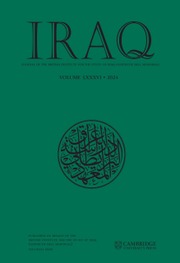No CrossRef data available.
Article contents
THE THIRD MILLENNIUM B.C.E. POTTERY SEQUENCE OF SOUTHERN MESOPOTAMIA: POTTERY CHRONOLOGY AS SEEN FROM TELL ZURGHUL/NIGIN, MOUND A
Published online by Cambridge University Press: 24 February 2025
Abstract
Excavations carried out between 2016 and 2022 on the main mound (Mound A) of Tell Zurghul/Nigin, in Areas D and E, have revealed a long occupational sequence of the site during a large part of the third millennium B.C.E. The identification of three main phases of use of the area, which are in turn divided into five Architectural Phases, shows that the mound was utilized in different ways between the late Early Dynastic I period and the end of the third millennium B.C.E. The sequence allows the various phases of use to be associated with specific periods in the life of the settlement, coinciding with the rulers of the First Dynasty of Lagash and Gudea’s works on the site. The chrono-typological analysis of the pottery repertoire from Areas D and E has established dating for the materials recovered and provides additional information useful for a general reassessment of the ceramic chronology of third millennium B.C.E. Mesopotamia. Materials from Architectural Phases I and II are assigned at the ceramic level to the late Akkadian/post-Akkadian/early Ur III horizon. Pottery from Architectural Phases III and IV are assigned, respectively, to the ED IIIB/early Akkadian and the ED IIIA–B horizons, while materials from Architectural Phase V are assigned to a late ED I/transitional ED I–ED IIIA horizon.
التسلسل الفخاري للألفية الثالثة قبل الميلاد في جنوب بلاد ما بين النهرين: التسلسل الزمني الفخاري كما يُرى من تل زرغول/نيجين، التل A
دافيد نادالي ولوكا فولبي
كشفت الحفريات التي أجريت بين عامي 2016 و2022 على التل الرئيسي (التل A) لتل زرغول/نيجين، في المنطقتين (D) و(E)، عن تسلسل استيطاني طويل للموقع خلال جزء كبير من الألفية الثالثة قبل الميلاد. يوضح تحديد ثلاث مراحل رئيسية لاستخدام المنطقة، والتي تنقسم بدورها إلى خمس مراحل معمارية، أن التل تم استخدامه بطرق مختلفة بين أواخر فترة الأسرة الأولى المبكرة ونهاية الألفية الثالثة قبل الميلاد. ويسمح التسلسل بربط مراحل الاستخدام المختلفة بفترات محددة من حياة المستوطنة، تتزامن مع عهود حكام الأسرة الأولى في لكش وكوديا في الموقع. قد حدد التحليل الزمني النموذجي لمخزون الفخار من المنطقتين D وE تأريخًا للمواد المستردة ويوفر معلومات إضافية مفيدة لإعادة تقييم عام للتسلسل الزمني للفخار للألفية الثالثة قبل الميلاد في بلاد ما بين النهرين. تم تحديد المواد الخزفية من المرحلتين المعماريتين الأولى والثانية بأنها تابعة الى المستوى الخزفي لأفق أواخر الفترة الأكدية / ما بعد الأكدية / أوائل أور الثالثة. تم تخصيص الفخار من المرحلتين المعماريتين III وIV، على التوالي، إلى آفاق ED IIIB/الأكادية المبكرة وED IIIA-B، في حين تم تعيين المواد من المرحلة المعمارية V إلى أفق ED I المتأخر / ED I – ED IIIA الانتقالي.
- Type
- Research Article
- Information
- Copyright
- © The British Institute for the Study of Iraq 2025


